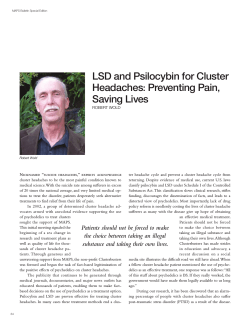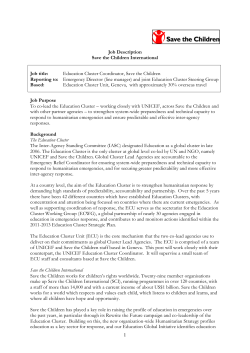
Treatment of Cluster Headache
Treatment of Cluster Headache Peter J Goadsby, MD, PhD, DSc Headache Group, Department of Neurology, University of California, San Francisco, San Francisco CA Cluster Headache is a very severe form of primary headache with a population one-year prevalence of about 0.1 %. Classified as a Trigeminal Autonomic Cephalagia (TAC), it is probably the second most common form of primary headache encountered by neurologists or headache specialists. Cluster headache (CH) comes in two dominant forms, episodic CH, in which there are breaks of a month or more without therapy (80% of patients), and chronic CH in which such breaks are not seen (20% of patients) (1). The medical management of CH may be divided into the treatment of the acute attacks, and preventive treatment, aimed at suppressing attacks during a bout (2). Acute and preventive treatments are begun simultaneously at the onset of a cluster period. New surgical options and neurostimulation have supplanted destructive treatment approaches. (3) Due to the relative rarity of the condition much of the treatment of CH has evolved from clinical experience rather than from randomized controlled trials (RCT). The designation of ‘(RCT)’ indicates that a controlled trial was performed. Many uses cited above are off-license and prescribers are encouraged to examine the relevant information in this regard. Acute attack treatment CH attacks are typically short, from 30 to 180 minutes, and often peak rapidly; they thus require a treatment with quick onset. Medication overuse headache can be seen in CH patients, typically if they have a co-existent history or family history of migraine, and when largely ineffective treatments are employed for acute attacks, such as oral triptans, acetaminophen and opiate receptor agonist analgesics. Oxygen: Inhaled oxygen, 100% at 10-12 L/min for 15 minutes is an effective, safe treatment of acute cluster headache (RCT). Triptans: Sumatriptan 6 mg subcutaneous, sumatriptan 20mg intranasal, and zolmitriptan 5 mg intranasal are effective in the acute treatment of cluster headache (RCT). Three doses of zolmitriptan in twenty-four hours are acceptable. There is no evidence to support the use of oral triptans in CH. Dihydroergotamine 1mg IM is effective in the relief of acute attacks of CH. The intranasal form seems less effective, although some patients benefit from its use. Lidocaine: Topical lidocaine nasal drops may be used to treat acute attacks of CH. The patient lies supine with the head tilted backwards toward the floor at 30 degrees and turned to the side of the headache. A nasal dropper may be used and the dose (1 mL of 4% lidocaine) repeated once after 15 minutes. Preventive treatments The options for preventive treatment in CH are determined largely by the bout length not by the designation of episodic versus chronic CH. Preventives may be regarded as short-term, or long-term, based on how quickly they act and how long they can be safely used. Most experts would now favor verapamil as the first-line preventive treatment of choice, although for some patients with short bouts limited courses of oral corticosteroids or a greater occipital nerve injection may be more appropriate. These shorter term approaches can also be employed as transitional therapy as longer term preventive doses are being increased. In general terms monotherapy in cluster headache is preferred, acknowledging that some patients, preferably managed by physicians with experience, will require more than one preventive. Verapamil is more effective than placebo and compares favorably with lithium. Clinical practice clearly supports the need to use relatively high doses for CH, certainly higher than those used in cardiological indications. After obtaining a baseline EKG, start patients on 80 mg three times daily; thereafter the total daily dose is increased in increments of 80 mg every 10-14 days. An EKG is performed prior to each increment and at least ten days after the dose change. The dose is increased until the cluster attacks are suppressed, side effects intervene or the maximum dose of 960 mg daily is achieved. Side effects include constipation and leg swelling and gingival hyperplasia (patients must monitor dental hygiene closely). Corticosteroids in the form of prednisone 1 mg/Kg up to 60 mg for four days tapering the dose over three weeks is a well accepted short-term preventive approach. It often stops the cluster period, and should be used no more than once a year to avoid aseptic necrosis. Lithium carbonate is mainly used in chronic CH because of its side effects, although it is sometimes employed in the episodic variety. The usual dose of lithium is 600 mg to 900 mg per day in divided doses. Lithium levels should be obtained within the first week and periodically thereafter with target serum levels of 0.4 to 0.8 mEq/L. Neurotoxic effects include tremor, lethargy, slurred speech, blurred vision, confusion, nystagmus, ataxia, extrapyramidal signs, and seizures. Concomitant use of sodium-depleting diuretics should be avoided, as they may result in high lithium levels and neurotoxicity. Long-term effects such as hypothyroidism and renal complications must be monitored in patients who use lithium for extended periods of time. Polymorphonuclear leukocytosis is a common reaction to lithium and is often mistaken for occult infection. Concomitant use with indomethacin can increase the lithium level. Topiramate is useful in the prevention of CH attacks. Typical doses are 100-200 mg daily, with the same adverse events as seen with its use in migraine. Melatonin may be helpful in CH as a preventive and there is one controlled trial demonstrating superiority to placebo. Doses of 9 mg daily are typically used. Other preventive agents include gabapentin (up to 3600 mg daily) and methysergide (3 to 12 mg daily). Methysergide is no longer easily available, and must always be used with breaks in therapy to avoid fibrotic complications. Divalproex is not effective (RCT). Greater occipital nerve injection: Injection of methylprednisolone (80 mg) with lidocaine into the area around the greater occipital nerve ipsilateral to the site of attack may result in remissions lasting from 5 to 73 days (RCT). This approach can be very helpful in shorter bouts and to provide a general reduction in burden in more prolonged bouts and in chronic CH. Surgical approaches: Modern surgical approaches to CH are dominated by deep brain stimulation in the region of the posterior hypothalamic grey matter and occipital nerve stimulation. In expert hands the results are excellent and appropriate referrals to expert centers are encouraged. There is no clear place for destructive procedures, such a trigeminal ganglion thermocoagulation or trigeminal sensory root section. Further reading 1. 2. 3. Lance JW, Goadsby PJ. Mechanism and Management of Headache. (7th ed.) New York: Elsevier, 2005. Goadsby PJ, Cohen AS, Matharu MS. Trigeminal autonomic cephalalgias- diagnosis and treatment. Current Neurology and Neuroscience Reports 2007;7:117-125. Goadsby PJ. Neurostimulation in primary headache syndromes. Expert Review in Neurotherapeutics 2007;7:1785-1789. American Headache Society • 19 Mantua Road, Mt. Royal, NJ, 08061 • 856.423.0043 • www.AmericanHeadacheSociety.org
© Copyright 2025





















